Related Research Articles
ALF Tales is a 30-minute Saturday morning animated series that aired on NBC from September 10, 1988, to December 9, 1989. The show is a spin-off of ALF: The Animated Series which featured characters from that series playing various characters from fairy tales. The fairy tale parody was usually altered for comedic effect in a manner akin to Jay Ward's "Fractured Fairy Tales".

A fairy tale is a short story that belongs to the folklore genre. Such stories typically feature magic, enchantments, and mythical or fanciful beings. In most cultures, there is no clear line separating myth from folk or fairy tale; all these together form the literature of preliterate societies. Fairy tales may be distinguished from other folk narratives such as legends and explicit moral tales, including beast fables. Prevalent elements include dragons, dwarfs, elves, fairies, giants, gnomes, goblins, griffins, merfolk, monsters, talking animals, trolls, unicorns, witches, wizards, magic, and enchantments.
"Cinderella", or "The Little Glass Slipper", is a folk tale with thousands of variants that are told throughout the world. The protagonist is a young girl living in forsaken circumstances that are suddenly changed to remarkable fortune, with her ascension to the throne via marriage. The story of Rhodopis, recounted by the Greek geographer Strabo sometime between 7 BC and 23 AD, about a Greek slave girl who marries the king of Egypt, is usually considered to be the earliest known variant of the Cinderella story.

'Puss' is a character in the fairy tale "The Master Cat, or Puss in Boots" by Charles Perrault. The tale was published in 1697 in his Histoires ou Contes du temps passé. The tale of a cat helping an impoverished master attain wealth through its trickery is known in hundreds of variants.

"Little Red Riding Hood" is a European fairy tale about a young girl and a sly wolf. Its origins can be traced back to several pre-17th-century European folk tales. The two best known versions were written by Charles Perrault and the Brothers Grimm.
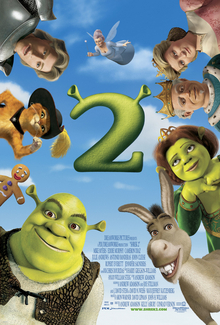
Shrek 2 is a 2004 American animated comedy film loosely based on the 1990 children's picture book Shrek! by William Steig. Directed by Andrew Adamson, Kelly Asbury, and Conrad Vernon from a screenplay by Adamson, Joe Stillman, and the writing team of J. David Stem and David N. Weiss, it is the sequel to Shrek (2001) and the second installment in the Shrek film series. The film stars Mike Myers, Eddie Murphy and Cameron Diaz, who reprise their respective voice roles of Shrek, Donkey, and Princess Fiona. They are joined by new characters voiced by Antonio Banderas, Julie Andrews, John Cleese, Rupert Everett, and Jennifer Saunders. Shrek 2 takes place following the events of the first film, with Shrek and Donkey meeting Fiona's parents as the zealous Fairy Godmother, who wants Fiona to marry her son Prince Charming, plots to destroy Shrek and Fiona's marriage. Shrek and Donkey team up with a sword-wielding cat named Puss in Boots to foil her plans.

Prince Charming is a fairy tale stock character who comes to the rescue of a damsel in distress and must engage in a quest to liberate her from an evil spell. This classification suits most heroes of a number of traditional folk tales, including "Snow White", "Sleeping Beauty", and "Cinderella", even if in the original story they were given another name, or no name at all.
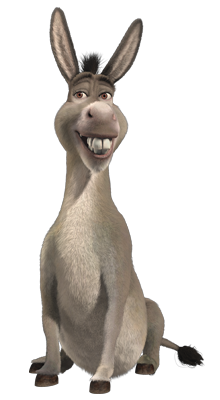
Donkey is a fictional character created by William Steig and adapted by DreamWorks Animation for the Shrek franchise. He is voiced primarily by Eddie Murphy. Donkey is an anthropomorphic donkey and his appearance is modeled after a miniature donkey named Perry. He is depicted with grey fur, brown eyes, and a black mane. In the franchise, he is the sidekick and best friend of Shrek, husband to Dragon, and father to a litter of Dronkeys (Dragon-Donkeys). As the series' comic relief character, Donkey is well-regarded by critics for his wit, wisdom, and humor.

Princess Fiona is a fictional character in DreamWorks' Shrek franchise, first appearing in the 1990 book Shrek! as the magnificent princess and subsequently in the animated film adaption of the same name as Princess Fiona. One of the film series' main characters, Fiona is introduced as a beautiful princess placed under a curse that transforms her into an ogre at night. She is initially determined to break the enchantment by kissing a prince, only to meet and fall in love with Shrek, an ogre, instead. The character's origins and relationships with other characters are further explored in subsequent films; she introduces her new husband Shrek to her parents in Shrek 2 (2004), becomes a mother by Shrek the Third (2007), and is an empowered warrior in Shrek Forever After (2010), much of which takes place in an alternate reality in which Fiona and Shrek never meet.
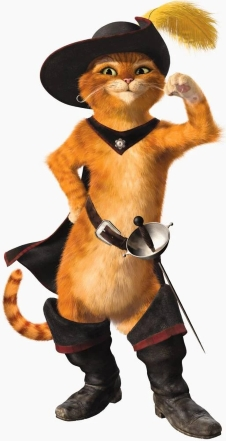
Puss in Boots, or simply Puss, is a main character in the Shrek franchise. He made his first appearance in the film Shrek 2 (2004), soon becoming Shrek's partner and helper. In the film Shrek the Third (2007), Puss helps Shrek find the heir to the throne of the Far Far Away Kingdom. The film Shrek Forever After (2010) is primarily set in an alternate universe, where Puss is Princess Fiona's pet and has gained weight after his retirement. He is portrayed as the title character and protagonist in the 2011 spin-off film Puss in Boots and its 2022 sequel, Puss in Boots: The Last Wish. Puss also appears in the Netflix television series centered on him, The Adventures of Puss in Boots (2015–2018).
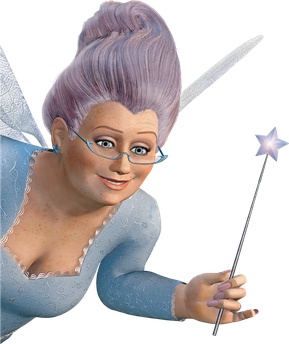
The Fairy Godmother is a fictional character in DreamWorks' Shrek franchise, voiced by actress Jennifer Saunders. Introduced as the main antagonist of Shrek 2, the Fairy Godmother is the mother of Prince Charming, who Princess Fiona was originally intended to wed prior to meeting Shrek. She plots against newlyweds Shrek and Fiona's relationship, using her magic and potions in an attempt to trick Fiona into falling in love with her son. She believes that ogres do not live happily ever after. Fairy Godmother is loosely based on the stock fairy godmother character in fairy tales, specifically "Cinderella" and "Sleeping Beauty", serving as a parody of the common trope.

Shrek is an American media franchise made by DreamWorks Animation, loosely based on William Steig's 1990 picture book Shrek!. The series primarily focuses on Shrek, a bad-tempered but good-hearted ogre, who begrudgingly accepts a quest to rescue a princess, resulting in him finding friends and going on many subsequent adventures in a fairy tale world. It includes four computer-animated films: Shrek (2001), Shrek 2 (2004), Shrek the Third (2007), and Shrek Forever After (2010). A short 4-D film, Shrek 4-D, which originally was a theme park ride, was released in 2003. Two television specials, the Christmas television special Shrek the Halls (2007) and the Halloween television special Scared Shrekless (2010), have also been produced. Two spin-off films were made centered around the character Puss in Boots: 2011's Puss in Boots and its sequel, 2022's The Last Wish. Additionally, a stage musical adaptation was made and premiered at Broadway for more than a year (2008–2010).
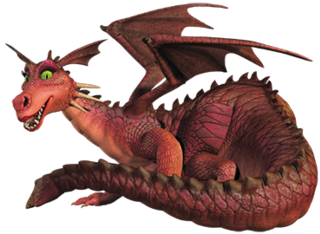
Dragon is a fictional character from the Shrek franchise, who is initially believed to be a fearsome villain guarding Princess Fiona. In a twist, she is revealed to be female and in search of love. While she is abandoned during Shrek's escape, she later becomes his ally and the wife of his sidekick, Donkey, helping defeat the evil Lord Farquaad by eating him whole. She has since appeared in every series film in some regard, with a parallel universe version becoming a villain in Shrek Forever After. Also appearing in spin-offs, she is commonly seen as a puppet in stage adaptations of the series such as Shrek the Musical.
Puss in Boots is a 1922 film directed by Walt Disney. The film was based on the book by Charles Perrault.

"Jack and the Beanstalk" is an English fairy tale. It appeared as "The Story of Jack Spriggins and the Enchanted Bean" in 1734 and as Benjamin Tabart's moralized "The History of Jack and the Bean-Stalk" in 1807. Henry Cole, publishing under pen name Felix Summerly, popularized the tale in The Home Treasury (1845), and Joseph Jacobs rewrote it in English Fairy Tales (1890). Jacobs' version is most commonly reprinted today, and is believed to be closer to the oral versions than Tabart's because it lacks the moralizing.

Shrek is a 2001 American animated fantasy comedy film loosely based on the 1990 children's picture book of the same name by William Steig. Directed by Andrew Adamson and Vicky Jenson and written by Ted Elliott, Terry Rossio, Joe Stillman, and Roger S. H. Schulman, it is the first installment in the Shrek film series. The film stars Mike Myers, Eddie Murphy, Cameron Diaz, and John Lithgow. In the film, an embittered ogre named Shrek (Myers) finds his home in the swamp overrun by fairy tale creatures banished by the obsessive ruler Lord Farquaad (Lithgow). With the help of Donkey (Murphy), Shrek makes a pact with Farquaad to rescue Princess Fiona (Diaz) in exchange for regaining control of his swamp.

Puss in Boots is a 2011 American animated adventure comedy film produced by DreamWorks Animation and distributed by Paramount Pictures. It is a spin-off of the Shrek film series and its fifth installment, rather than an adaptation of the fairytale "Puss in Boots". The film was directed by Chris Miller with a screenplay by Tom Wheeler from a story by Brian Lynch, Will Davies, and Wheeler, based on the character from Shrek 2 (2004) and inspired from the Puss in Boots fairy tale. It stars Antonio Banderas, alongside Salma Hayek, Zach Galifianakis, Billy Bob Thornton, and Amy Sedaris. The film follows the origin story of Puss in Boots (Banderas) during his adventure years before the events of Shrek 2. Accompanied by his friends, Humpty Dumpty (Galifianakis) and Kitty Softpaws (Hayek), Puss is pitted against Jack and Jill, two murderous outlaws, for ownership of three legendary magical beans that lead to a great fortune of Golden Eggs from the Great Terror, a gigantic Goose.

In fairy tales, a true love's kiss is a motif and commonly used trope whereby a kiss from a "true love" possesses magical powers and holds significant importance.
References
- ↑ Kinsella, Marilyn A. "Fractured Fairy Tales". Taleypo the Storyteller. Retrieved July 25, 2012.
- ↑ Poniewozik, James (May 10, 2007). "Is Shrek Bad for Kids?". Time . Archived from the original on June 17, 2007. Retrieved April 2, 2012.
- 1 2 3 Schwabe, Claudia (September 27, 2016). "The Fairy Tale and Its Uses in Contemporary New Media and Popular Culture Introduction". Humanities. 5 (4): 81. doi: 10.3390/h5040081 . ISSN 2076-0787.
- 1 2 Zipes, Jack (1988). "The Changing Function of the Fairy Tale". The Lion and the Unicorn. 12 (2): 7–31. doi:10.1353/uni.0.0236. ISSN 1080-6563. S2CID 144272360.
- ↑ Zipes, Jack (2011). "The Meaning of Fairy Tale within the Evolution of Culture". Marvels & Tales. 25 (2): 221–243. doi:10.1353/mat.2011.a462732. ISSN 1521-4281. JSTOR 41389000.
- ↑ Tiffin, Jessica (2006). "Ice, Glass, Snow: Fairy Tale as Art and Metafiction in the Writing of A. S. Byatt". Marvels & Tales. 20 (1): 47–66. doi:10.1353/mat.2006.0018. ISSN 1536-1802. S2CID 144749940.
- 1 2 Reynolds, Kimberley; Zipes, Jack (April 1, 2008). "Why Fairy Tales Stick: The Evolution and Relevance of a Genre". The Modern Language Review. 103 (2): 503. doi:10.2307/20467798. ISSN 0026-7937. JSTOR 20467798.
- ↑ Zipes, Jack (March 19, 2012). The Irresistible Fairy Tale : the Cultural and Social History of a Genre. Princeton University Press. ISBN 978-1-4008-4182-0. OCLC 979685942.
- 1 2 Reynolds, Kimberley (2008). "Review of Why Fairy Tales Stick: The Evolution and Relevance of a Genre". The Modern Language Review. 103 (2): 503–504. doi:10.2307/20467798. ISSN 0026-7937. JSTOR 20467798.
- 1 2 3 Athanasiou-Krikelis, Lissi (2019). "Picture-Book Retellings of "The Three Little Pigs": Postmodern Parody, Intertextuality, and Metafiction". Children's Literature Association Quarterly. 44 (2): 173–193. doi:10.1353/chq.2019.0024. ISSN 1553-1201. S2CID 182356482.
- 1 2 3 4 5 Critical and creative perspectives on fairy tales: an intertextual dialogue between fairy-tale scholarship and postmodern retellings. November 1, 2011.
- ↑ Zipes, Jack (April 8, 2012), "The Cultural Evolution of Storytelling and Fairy Tales: Human Communication and Memetics", The Irresistible Fairy Tale, Princeton University Press, doi:10.23943/princeton/9780691153384.003.0001, ISBN 9780691153384 , retrieved May 11, 2022
- ↑ Van de Walle, Etienne (2001). "A Comment on Fertility Control and the Fairy-Tale Heroine". Marvels & Tales. 15 (1): 128–131. doi:10.1353/mat.2001.0016. ISSN 1536-1802. S2CID 201741878.
- ↑ Bacchilega, Cristina (November 2013). Fairy Tales Transformed: Twenty-First-Century Adaptations & the Politics of Wonder. Detroit, Michigan, United States: Wayne State University Press. pp. 3–49. ISBN 9780814334874.
- 1 2 3 4 5 Bacchilega, Cristina (2013). Fairy tales transformed?: twenty-first-century adaptations and the politics of wonder. Detroit, MI: Wayne State University Press. ISBN 978-0-8143-3928-2. OCLC 870177329.
- ↑ Howard, Morgan (April 18, 2018). "Twice Upon a Time: The Retellings of Fairy Tales for Contemporary Audiences". Scholarly Commons. Retrieved May 24, 2022.
- 1 2 3 4 5 Williams, Christy (2010). "Who's Wicked Now? The Stepmother as Fairy-Tale Heroine". Marvels & Tales. 24 (2): 255–271. doi:10.1353/mat.2010.a402475. ISSN 1521-4281. JSTOR 41388955. S2CID 163033162.
- 1 2 3 Rosenberg, Teya; Schwenke Wyile, Andrea (2008). Considering children's literature : a reader. Broadview Press. ISBN 978-1-55111-604-4. OCLC 182040347.
- 1 2 Haase, Donald (2000). "Feminist Fairy-Tale Scholarship: A Critical Survey and Bibliography". Marvels & Tales. 14 (1): 15–63. ISSN 1521-4281. JSTOR 41380741.
- 1 2 3 4 5 6 7 Leduc, Amanda (2020), Disfigured : on fairy tales, disability, and making space, Toronto, ISBN 978-0-221-04580-6, OCLC 1140509658 , retrieved May 26, 2022
{{citation}}: CS1 maint: location missing publisher (link) - 1 2 3 Attebery, Brian (2018). "Reinventing Masculinity in Fairy Tales by Men". Marvels & Tales. 32 (2): 314–337. doi:10.13110/marvelstales.32.2.0314. ISSN 1521-4281. JSTOR 10.13110/marvelstales.32.2.0314. S2CID 192578432.
- ↑ Kinsella, Marilyn A. "Fractured Thoughts Workshop: Fractured folk tales including fairy tales, fables, myths". Taleypo the Storyteller. Retrieved April 16, 2014.